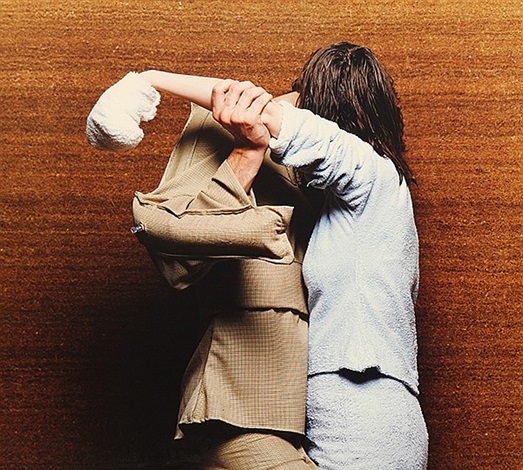No copyright infringement intended - photographs will be removed immediately upon request.
The chapter 2 considers the use of storytelling in contemporary art photography.
This area of photographic practise is often described as tableau or tableau-vivant photography, for pictorial narrative is concentrated into a single image: a stand alone picture.
One of the leading practitioners of the staged tableau photograph is the Canadian artist Jeff Wall.
He describes his work as having two broad areas. One is an ornate style in which the artifice of the photograph is made obvious by the fantastic nature of his stories. The other is the staging of an event that appears much slighter, like a casually glanced-at-scene.
He is similar to a film director who imaginatively harnesses collective fantasies and realities.
Jeff Wall - Insomnia, 1994
Philip-Lorca diCorcia's "Hollywood" is a series of portraits of men whom diCorcia met in and around Santa Monica Bd in Hollywood and asked to pose for him.
The titles of each photo tell you the name, his age, where he was born and how much he was paid to pose.
The pictures encourage a kind of storytelling in the viewer's mind.
Philip-Lorca diCorcia - Eddie Anderson; 21years old; Houston, TX; $20, 1990-92
Tableau photography often refers to specific works of earlier art.
The British artist Sam Taylor-Wood's "Soliloquy I" shows the figure of a beautiful young man expired on a sofa, his right arm hanging lifelessly to the floor.
This pose emulates a popular work by the Victorian painter Henry Wallis (The Death of Chatterton).
Taylor-Wood consciously revives the idealism bound up in Wallis's painting.
Henry Wallis - The Death of Chatterton, 1856
Sam Taylor-Wood's - Soliloquy I, 1998
Dutch artist Liza May Post's photographs and films have magical, dream-like qualities.
In "Shadow" both figures are dressed in androgynous clothes that hide their gender and age.
The details in the photo are hyper-real and, like a surreal dream, their combination and visual charge leave the narrative open to the viewer's interpretation.
Liza May Post - Shoulderblades: Shelter, 1996
The Cuban artist Deborah Mesa-Pelly recasts fairy tales and popular stories with young female characters and with disturbing results.
Mesa-Pelly stages situations that could be scenes from the stories as they are conventionally told, but dramatised and given a sinister edge by her lighting and voyeuristic camera angles.
Deborah Mesa-Pelly - Legs, 1999
Anna Gaskell's photographs share an intense storytelling quality that combines a number of the common devises of tableau photography: a cast of children, sometimes with their faces obscured, their play gone awry or turned nasty.
The physical beauty of the prints, combined with the moral ambiguity of the narrative, makes for an unnerving visual pleasure.
Anna Gaskell - Untitled #59, 1999
British artist Christopher Stewart photographs private security firms finding contemporary allegories for Western insecurity and paranoia.
Christopher Stewart - United States of America, 2002
German artist Rut Blees Luxemburg uses the elemental devises of lighting and water reflections to create magnificent amber imagery of urban architecture.
In "In Deeper" the viewer is placed within the scene at the top of the steps of a river embankment.
Footprints are left in the wet silt on the steps leading into the luminescent river, revealed by raking lighting.
Rut Blees Luxemburg - In Deeper, 1999









No comments:
Post a Comment